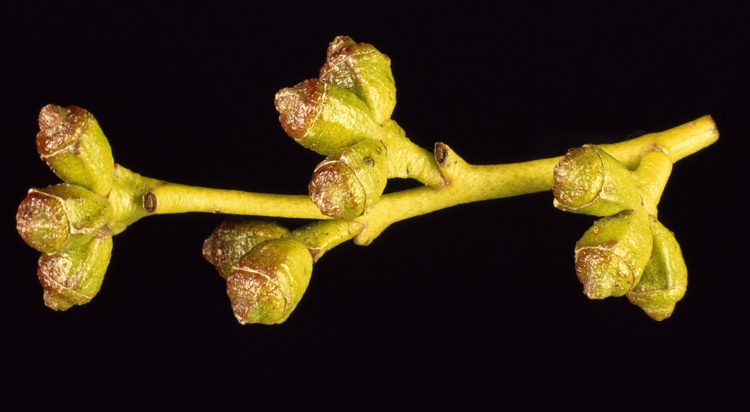Eucalyptus Johnstonii on:
[Wikipedia]
[Google]
[Amazon]
''Eucalyptus johnstonii'', commonly known as Tasmanian yellow gum, is a species of medium-sized to tall tree 

endemic
Endemism is the state of a species being found in a single defined geographic location, such as an island, state, nation, country or other defined zone; organisms that are indigenous to a place are not endemic to it if they are also found elsew ...
to Tasmania. It has smooth yellow to greenish bark, lance-shaped adult leaves, flower buds in groups of three, white flowers and hemispherical or bell-shaped fruit.

Description
''Eucalyptus johnstonii'' is a tree that typically grows to a height of and forms alignotuber
A lignotuber is a woody swelling of the root crown possessed by some plants as a protection against destruction of the plant stem, such as by fire. Other woody plants may develop basal burls as a similar survival strategy, often as a response t ...
. It has smooth yellow to brownish or greenish bark, sometimes with persistent fibrous bark near the base. Young plants and coppice
Coppicing is a traditional method of woodland management which exploits the capacity of many species of trees to put out new shoots from their stump or roots if cut down. In a coppiced wood, which is called a copse, young tree stems are repeated ...
regrowth have stems that are more or less square in cross-section with a broad wing on each corner and sessile
Sessility, or sessile, may refer to:
* Sessility (motility), organisms which are not able to move about
* Sessility (botany), flowers or leaves that grow directly from the stem or peduncle of a plant
* Sessility (medicine), tumors and polyps that ...
. The juvenile leaves are egg-shaped to almost round, long, wide and arranged in opposite pairs. Adult leaves are lance-shaped or curved, more or less the same glossy green on both sides, long and wide on a petiole long. The flower buds are arranged in leaf axils on a thick, unbranched peduncle long, the individual buds sessile. Mature buds are oblong to diamond-shaped, long and wide with a rounded operculum with a central knob. Flowering mainly occurs from February to April and the flowers are white. The fruit is a woody hemispherical or bell-shaped capsule long and wide with the valves protruding above the rim of the fruit.
Taxonomy and naming
''Eucalyptus johnstonii'' was first formally described in 1922 byJoseph Maiden
Joseph Henry Maiden (25 April 1859 – 16 November 1925) was a botanist who made a major contribution to knowledge of the Australian flora, especially the genus ''Eucalyptus''. This botanist is denoted by the author abbreviation when citing ...
and the description was published in Volume 6 of his book, ''A Critical Revision of the Genus Eucalyptus''. The specific epithet
In taxonomy, binomial nomenclature ("two-term naming system"), also called nomenclature ("two-name naming system") or binary nomenclature, is a formal system of naming species of living things by giving each a name composed of two parts, bot ...
honours Robert Mackenzie Johnston
Robert Mackenzie Johnston Fellow of the Linnean Society, F.L.S., (27 November 1843 – 20 April 1918)R. L. Wettenhall,Johnston, Robert Mackenzie (1843 - 1918), ''Australian Dictionary of Biography'', Volume 9, Melbourne University Press, MUP, 198 ...
.
Maiden noted that the species had already been described in 1886 by Thomas Bather Moore
Thomas Bather Moore (1850 1919) was a pioneer explorer of Western and South West, Tasmania, Australia.
Biography
He was born at New Norfolk and died at Queenstown. He was buried at the graveyard Strahan overlooking Macquarie Harbour.
He was ...
. Moore gave it the name ''Eucalyptus muelleri'', a name that was already used for a different species, making it an illegitimate name
''Nomen illegitimum'' (Latin for illegitimate name) is a technical term, used mainly in botany. It is usually abbreviated as ''nom. illeg.'' Although the International Code of Nomenclature for algae, fungi, and plants uses Latin terms for other ki ...
. Maiden gave a further description and a diagram of the same species in Volume 3 of his book.
Distribution and habitat
Tasmanian yellow gum grows in tall forest on mountains and plateaus in south-eastern Tasmania including on Mount Wellington,Bruny Island
Bruny Island ( Nuenonne: Lunawanna-alonnah) is a island located off the south-eastern coast of Tasmania, Australia. The island is separated from the Tasmanian mainland by the D'Entrecasteaux Channel, and its east coast lies within the Tasman S ...
and the Tasman Peninsula
The Tasman Peninsula, officially Turrakana / Tasman Peninsula, is a peninsula located in south-east Tasmania, Australia, approximately by the Arthur Highway, south-east of Hobart.
The Tasman Peninsula lies south and west of Forestier Peninsula ...
.
See also
* List of ''Eucalyptus'' speciesReferences
{{Taxonbar, from=Q15398368 Trees of Australia johnstonii Endemic flora of Tasmania Plants described in 1922 Taxa named by Joseph Maiden